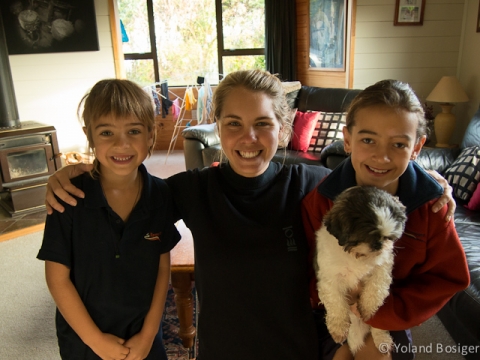Rebreather diving was game changer. Up until this point in my diving journey there were a couple of simple truths I had come to expect. First, was that you should hear and feel bubbles escaping from the side of your regulator as you exhale; not true for rebreathers. Second, when planning a multi-level dive to a max depth of 20 m you should usually expect your air to last for approximately 50-70 minutes; not true for rebreathers, and third, on taking a deep breath in, your buoyancy should become positive allowing you to craftily rise above the substrate with perfect trim; sadly also not true for rebreathers. Lets just say I could now see why we weren’t being exposed to anything fragile and coral-like on our first rebreather dive!
I was picked up from the airport by the legendary Pete Mesley, who had very generously invited me to come and participate in his TDI Air Diluent Closed Circuit Rebreather (CCR) Diver Course. I was unconditionally welcomed into Pete’s house with his wife, Kim and two lovely kids Hannah and Chloe. These guys were truly wonderful to me, providing me with my own room and constantly telling me help myself to everything. I felt right at home and am so grateful for their kindness.
So why do a rebreather course? There are a huge number of massive benefits but first and foremost (from a technical point of view) is that rebreathers are more efficient on air. At normal atmospheric pressure, human lungs absorb approximately 5% of the oxygen present in air with exhaled air still containing roughly 16% oxygen. This makes open circuit diving very inefficient. Rebreathers on the other hand, recirculate the exhaled gas and replace the metabolised gas with fresh oxygen. Rebreathers also remove the carbon dioxide from each breath allowing a safe breathing mix. This permits a diver using a rebreather to carry a small portion of the gas that would be needed in an open-circuit system.
Rebreather theory was held over two relatively intense days at Pete’s house where I met my fellow partners in crime, John and Phil who would be participating in the course with me. Thanks to the incredible generosity of Ambient Pressure Diving, I was able to have an Evolution rebreather to train on while doing this course. We learned all about the parts of the unit and its operation, the physics of diving, warning signals and emergency drills. Rebreather diving is definitely something that you want to fully understand as the consequences of just ‘winging it’ can be dire. Understanding also allows you to detect signs of a problem early on, giving you plenty of time to react and safely complete the dive.
The next couple of days were spent reading my rebreather manuals while practicing to pack and unpack my unit. Pete also spent one morning helping me with my above water photography techniques and went all out setting up a little studio with coloured background and props. On Pete’s recommendation we decided Barbie would make a perfect subject for our photography lesson and we experimented with the effect of adding torch light at different angles – a simple and effective exercise for illustrating different lighting techniques.
During those free days, I was also lucky enough to visit Dave Moran, editor of the Dive New Zealand Magazine for a an hour or so in Auckland. I really enjoyed listening to Dave’s stories and have to say a big thank you to him for all the magazines and stickers. Dive New Zealand rocks!
We completed the majority of our initial rebreather dives in Lake Pupuke. With our setup checklists in hand, we slowly assembled our units and loaded them into Pete’s you beaut new stationwagen. Drysuits were definitely a necessity and considering it was only my second real dive in a drysuit as well as my second dive with my rebreather, you could say I was a little nervous. Or as Pete likes to put it, “Yolly had a healthy dose of apprehension.”
We walked (or in my case waddled) to the Lake Pupuke jetty and made out descent. Not unlike a penguin, I like to think that I regained my more graceful disposition upon hitting the water. The rebreather unit at least felt a lot more comfortable and streamlined underwater. I might, however have been a bit optimistic about my diving. Mask cleared and open/closed circuit drills completed, I followed Pete further and further into the gloom. There were so many toggles and buttons to get your head around and everything felt so foreign and strange, especially the fact that breathing did absolutely nothing to adjust my buoyancy. The combination of many new gadgets and the need to manually adjust my buoyancy meant that I spent most of my dive with my nose in the silt – what a pro, not!
After two days at the lake it was time for the real deal. Diving in the open water at the Poor Knights! Pete, Phil, Johno and I all packed in Pete’s car and headed for the Tutukaka, a small town near Wangarai where we met Peter Alexander (a previous Mesley student) and had incredibly scrumptious Thai food.
We joined a number of Pete’s previous students and members of The Breatheren (Rebreather Divers NZ) on Yukon Dive early next morning for our first day at the Knights. And what spectacular site they were. Remnants of an ancient volcano, these high relief islands are littered with intricate caves and archways and are home to spectacular marine life.
Gearing up in the back of the boat with seven or so other rebreather divers required some technique. Especially with the stage bottle attached, as one foot wrong meant that overbalancing followed closely by falling flat on your face was inevitable. We did heaps of emergency drills on that first day so you had know what you were doing. Low oxygen, high oxygen, cell error, low battery, burst hose; you name it Pete had the card for it. To be honest it was a bit of a skill in itself just to keep calm and think things through logically when you have a very serious Pete Mesley hovering a meter in front of you (all part of his stealthy plan to get us to react rationally if things where really going wrong).
On the morning of the last day, something quite incredible happened. I got it! I felt comfortable and in control of all my gear and was able to appreciate what was going on around me. It was absolutely awesome. Swimming for 90 or so minutes at 20 m and just being able to enjoy. Unlike open circuit where the methodical blast of bubbles can deter even the most daring of fish, here the fish were completely relaxed, swimming right up to me to say hello. This is what I had been waiting for and I remember being so stoked that all Pete’s hard work had paid off – thanks Pete! Your training was excellent and I am super exited to use the rebreather again and explore all the possibilities this type of diving has to offer.
For all those ever thought of doing a rebreather course I would say go for it! Just remember to come with an open mind, and as Pete says, don’t be too hard on yourself. This is a new way of diving so it will take a bit of time. Also, probably the best bits of advice I got was to follow checklists, be methodical, and in the words of Pete Mesley, “DON’T BREAK YOUR OWN RULES”.
Rebreather diving is exiting, fun and incredibly rewarding, but you have to be ready to work hard, to be challenged, and be pushed to re think and evaluate how you dive. This is definitely not the course for sissies!













Hey Yolly, a really fabulous blog post… sounds like you really had your work cut out for you this time. Remind all those who are so kind to you that they are always welcome to come swim in some warm water in North Queensland – thanks Janis